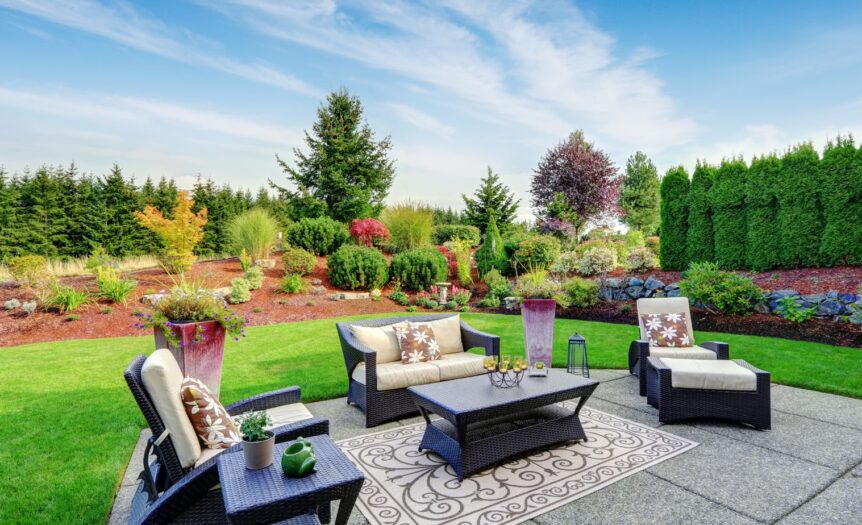When properly designed, your patio can become the perfect outdoor space for relaxation and entertainment. However, in today’s world, where sustainability and style go hand in hand, designing an outdoor oasis involves more than just aesthetics.
From understanding the basics of patio design to landscaping, discover how to transform it into the perfect outdoor oasis!
Evaluate Your Outdoor Space
Take some time to assess your patio. Measure the size, shape, ground condition, and overall layout. If there is a need for any repairs, invest in them first. Another essential aspect to consider is privacy and exposure. Your patio might need additional fences, privacy screens, or landscaping if it has no barriers for privacy or shade.
Pick a Style
Perfect outdoor oases feel like natural extensions of the property. Pick a style that complements your home’s architecture and your family’s vibe. Some popular patio designs include classic with traditional furniture, modern with minimalist features, and rustic with wooden and stone ornaments. Make sure to factor in the materials, color schemes, furniture, and other decorations before choosing a theme.
Choose Eco-Friendly Furniture
Furniture influences both the functionality and aesthetic appeal of your outdoor oasis. Prioritize comfortable seating options like Outdoor sofas, armchairs, and chaise lounges with weather-resistant fabrics and cushions. Don’t forget to add functional tables. Look for side coffee tables with built-in coolers or storage compartments. However, consider the space available and do not make the patio overcrowded.
We also recommend reusing old furniture. Not only will it save you some money, but it will also minimize waste. Thrift local stores, garage and estate sales, or check your storage for some pieces. Give them a fresh look with a coat of paint, replace the worn fabric with durable outdoor ones, and mix and match various pieces to create an eclectic space.
Upcycled pieces can also add a vintage flair to your outdoor oasis.
Add Greenery and Plants
Creating a captivating and lush backyard starts with selecting plants that enhance your design. Choose a mix of flowers, shrubs, and trees to add color, texture, and vibrancy. For a low-maintenance patio oasis, opt for drought-resistant succulents and perennial flowers. These options require minimal care and are adapted to several climates.
Incorporate native species that thrive in your region’s temperature, rainfall, and soil conditions. You can also grow herbs, vegetables, or fruits to create a functional and beautiful landscape.
Create Focal Points
Transform your patio into a captivating retreat by strategically placing focal points. Use elements to create visual intrigue and make your patio truly enchanting like:
- Add well-designed flower beds and borders. Play with color schemes, textures, and plant heights to create a dynamic and appealing arrangement.
- Opt for sculptures made from natural, biodegradable materials like stone, clay, or sustainably sourced wood, which are eco-friendly and blend seamlessly with the natural environment. Ensure that any finishes or paints used on the sculpture are non-toxic to prevent the release of harmful chemicals into your outdoor space.
- Incorporate a fire pit for a warm and inviting atmosphere.
- If you have a big enough space, consider a tabletop fountain or a garden pond. Ensure that the sound of water is soothing, not overwhelming.
However, do not incorporate all, as it will create a cluttered feel.
Use Energy Efficient Lighting and Water Systems
For a sustainable patio design, it’s important to invest in energy-efficient lighting and water systems.
Install LED lighting instead of traditional ones, as it consumes less energy. Alternatively, you can go for solar-powered lights and install motion sensors to ensure lights are only on when needed.
If you happen to be in an area where it rains a lot, consider rainwater harvesting for maintaining your greenery. Install rain barrels for collecting rainwater. Use drip irrigation systems to deliver water directly to the roots, reducing water waste. You can also apply mulch to retain soil moisture, reducing the need for frequent watering.
Consider Legal Regulations
In the United States, legal requirements for designing a patio, such as permits and licenses, vary by state. For instance, New Mexico requires a building permit for patios attached to the house or if the structure is large or elevated. You or your contractor must meet New Mexico contractor’s license requirements to ensure the project adheres to state regulations.
In contrast, states like Arizona have more lenient requirements. In Arizona, permits are generally not required for patio covers under 200 square feet supported by an exterior wall, and other minor projects like non-habitable accessory buildings also fall under permit exemption.
California, on the other hand, is stricter and typically requires permits for most patio projects.
Therefore, check with local authorities to ensure compliance with specific requirements for your patio project.
Conclusion
Sustainable patio designs are a growing trend in the architectural landscape. They create tranquil outdoor spaces for families to enjoy and relax. With our tips, you can bring life to your patio in no time, creating a beautiful, functional, and compliant outdoor space!
However, it’s also essential to understand and adhere to the legal requirements for designing a patio in your state. You can consult contractors in your area or search governmental sites for more information.










